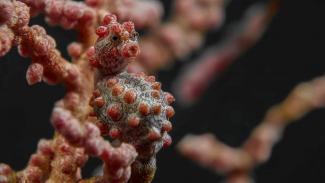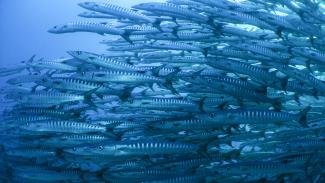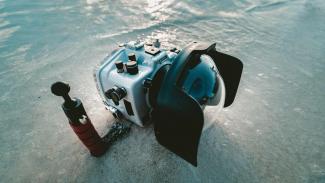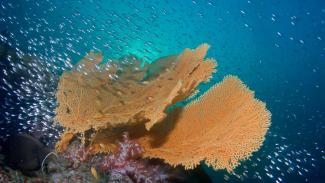Everything you need to know about dving around Lankayan Island
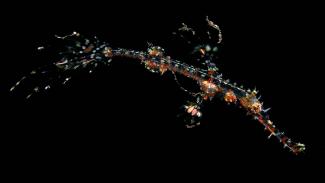
The picturesque island of Lankayan is now regarded as one of Malaysia’s finest dive destinations.
The island, which is just off east the coast of Borneo in the Sulu Sea, has only one resort, ensuring uncrowded dive sites and plenty of relaxation.
Just a few minutes from the island are numerous interesting dive sites, including three wrecks, plenty of macro life, some colourful reefs & - in season - the chance to see Whalesharks.
Highlights
Best diving spots
Just a few minutes from the island are numerous interesting dive sites, including 3 wrecks, plenty of macro life, some colourful reefs & - in season - the chance to see Whalesharks. A couple of kilometres to the south of Lankayan is Jawfish Layer. This site has an excellent variety of both hard & soft corals and is a favourite site. It is possible to find all manner of macro delights here - many Frogfish lie perfectly camouflaged in ambush, Ghost Pipefish are common, quite a few different species of Nudibranch’s can be found and even the elusive Mimic Octopus can be seen here if you are lucky.
Further south, the Katcing Group of islands have some dive sites that are also good for small things, especially Nudibranch's. The area also has some larger inhabitants. Look on the sand and you will see the eyes of Stingrays cautiously following you, while Leopard Sharks can also be seen taking a nap. The site gets its name from the Yellow Jawfish though. This curious-looking fish can be found in with its head sticking out of the rubble. Look closely, and you may notice that its mouth is full of tiny eggs.
Moskito Wreck, just to the east of Lankayan, is a great wreck for diving. The Japanese ship came to grief in WWII and now sits between 10 and 25 metres of water in calm conditions, allowing divers plenty of time to uncover its mysteries. The ship is in excellent condition, the main structure is still intact and the ship’s gun still perches proudly on the bow.
Barracuda & large schools of Trevally are often seen around the wreck, while the structure itself is an excellent spot to look for small critters. Lankayan Wreck & another small wreck just off the main jetty are also good dives, with plenty of macro delights to be found, including Ornate Ghost Pipefish & Painted Frogfish. To the north are more enjoyable shallow reefs with excellent corals that hide plenty of unusual life.
The big draw of the area is the seasonal appearance of Whale Sharks though. Around April & May, Lankayan is an excellent place to encounter these gentle giants as they cruise past on their ancient migration routes.
Turtles are also fairly common and the island itself is a breeding ground for both Green & Hawksbill Turtles. Bumphead Parrotfish & large Groupers are also regularly seen, as are Octopus & Cuttlefish. Those who are really lucky may even bump into a docile Dugong.
When to dive
Lankayan can be dived year-round, offering easy diving, calm seas & an excellent diversity of life. April & May is the time for Whale Shark encounters
Getting there
The island is reached by boat from Sandakan on the mainland. The closest major airport is Kota Kinabalu, the capital of Sabah in the north of the state.
Activities
Once the diving is over, relaxing, enjoying the picture perfect setting & marvelling at the island's tranquility are about as active as Lankayan gets.
Resort and liveaboard options
Lankayan has one sole dive resort with an excellent reputation. Lankayan Island Dive Resort offers well appointed chalets for guests and offers daily diving to all the best local dive sites. The resort will also arrange transfers to Lankayan Island.
You might also enjoy...
Lembeh Strait
Lembeh Strait separates little Lembeh island from the north-eastern shores of Sulawesi. It is famed for its exceptional muck diving.
The coastline either side of the Lembeh Strait has a rugged beauty, but it is the action below the waves that draws divers here.
Sipadan & Mabul Island
Sipadan is Malaysia’s most famous diving spot. Nearby, Mabul Island offers more excellent diving for smaller marine life, and a good choice of dive resorts.
These nutrient-rich waters attract huge numbers of Turtles, while the area is also home to large number of White-tip Reef Sharks, Bumphead Parrotfish, Trevally and Barracuda.
Setting up your underwater housing
Have you recently purchased an underwater housing for your camera? Maybe you feeling a little unsure how to set-up your new system correctly and are feeling in need of some tips and advice.
Don't despair. No matter what brand your housing, whether it is a simple own-brand housing or a state-of-the-art set-up, there are steps you can take every time you take your camera into the water to ensure that it is set-up correctly.
Similan & Surin Islands
The Similan Islands in Thailand are the country's most famous diving destination, offering great visibility, stunning corals and prolific marine life.
Accessed primarily by liveaboard, the Similan Islands are in a strictly controlled marine park and are considered by many to be the crown jewels of Thailand’s diving. As well as the diving, they also offer picture perfect beaches and unspoilt habitats.
Scuba diving in Borneo - 7 key questions answered
Tara North
For most people, Borneo conjures up visions of pristine rainforests and incredible wildlife encounters. This is all true, however for scuba divers, the magic continues beneath the blue.
Scuba diving in Borneo promises world-class dive sites, vibrant reefs and incredible marine life, from the green turtles of Sipadan Island to remote and spectacular diving in Borneo Indonesia.
Dummie's guide to camera kit
Jakob Owens


